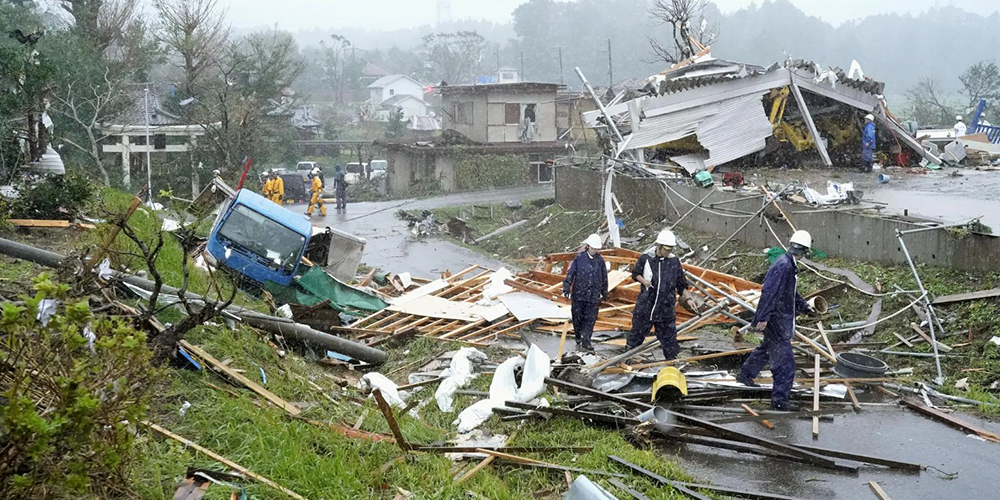What is Typhoon?
A tropical cyclone is a rotating, organized system of clouds and thunderstorms that originates over tropical or subtropical waters and has a closed low-level circulation. Tropical cyclones rotate counterclockwise in the Northern Hemisphere. They are classified as follows:
Tropical Depression: A tropical cyclone with maximum sustained winds of 38 mph (33 knots) or less.
Tropical Storm: A tropical cyclone with maximum sustained winds of 39 to 73 mph (34 to 63 knots).
Hurricane: A tropical cyclone with maximum sustained winds of 74 mph (64 knots) or higher. In the western North Pacific, hurricanes are called typhoons; similar storms in the Indian Ocean and South Pacific Ocean are called cyclones.
Major Hurricane: A tropical cyclone with maximum sustained winds of 111 mph (96 knots) or higher, corresponding to a Category 3, 4 or 5 on the Saffir-Simpson Hurricane Wind Scale.

Do Typhoons Happen in the US?
The Atlantic hurricane season runs from June 1 to November 30. The Atlantic basin includes the Atlantic Ocean, the Caribbean Sea, and the Gulf of Mexico. Based on a 30-year climate period from 1991 to 2020, an average Atlantic hurricane season has 14 named storms, 7 hurricanes, and 3 major hurricanes (Category 3, 4, or 5 on the Saffir-Simpson Hurricane Wind Scale). The first named storm typically forms in mid to late June, the first hurricane tends to form in early to mid-August, and the first major hurricane forms in late August or early September.
The eastern Pacific hurricane season runs from May 15 to November 30. The eastern Pacific basin extends from Mexico and Central America westward to 140°W. Based on a 30-year climate period from 1991 to 2020, an average eastern Pacific hurricane season has 15 named storms, 8 hurricanes, and 4 major hurricanes. The first named storm typically forms in early to mid-June, the first hurricane tends to form in late June, and the first major hurricane forms in mid-July.
Precautions When Living in a Typhoon-Prone Region
Living in a typhoon-prone region requires specific precautions and preparedness measures to ensure the safety of individuals and properties.
1. Stay Informed: Keep yourself updated with the latest weather forecasts, typhoon warnings, and evacuation notices issued by local authorities. Pay attention to official sources such as meteorological agencies and emergency management agencies.
2. Prepare an Emergency Kit: Have an emergency kit ready that includes essential items such as non-perishable food, water, flashlights, batteries, first aid supplies, medications, important documents (ID, insurance papers), cash, and basic tools.
3. Secure Your Home: Reinforce your home's structural integrity by securing loose objects outdoors, trimming trees and branches that could potentially fall on your property, and reinforcing doors, windows, and roofs. Consider installing storm shutters or protective covers for windows.
4. Evacuation Plan: Develop and familiarize yourself with an evacuation plan in case authorities issue evacuation orders. Know the nearest evacuation shelters or safe locations, and have a communication plan with family members or neighbors.
5. Stock Up on Supplies: Before a typhoon hits, stock up on supplies such as food, water, medications, and other essentials that can sustain you and your family for several days in case of power outages or restricted access to stores.
6. Secure Outdoor Items: Secure or bring indoors any outdoor items that could become projectiles during high winds, such as patio furniture, grills, and garden decorations. These items can cause damage to your property or pose hazards during a typhoon.
7. Prepare for Power Outages: Typhoons often cause power outages. Have alternative sources of power such as generators, battery-powered lights, and portable chargers for electronic devices. Use candles or battery-powered lanterns safely to avoid fire hazards.
8. Stay Indoors During the Storm: When a typhoon is approaching, stay indoors and away from windows. Avoid going outside unless necessary, as flying debris and strong winds can be extremely dangerous.
9. Stay Away from Flooded Areas: Avoid walking or driving through flooded streets or areas. Floodwaters can be contaminated and pose health risks, and vehicles can be swept away by swift currents. Follow evacuation orders if flooding becomes a threat.
10. Check on Neighbors: Keep an eye out for neighbors, especially the elderly, disabled, or those with special needs. Offer assistance if needed and ensure everyone in your community is aware of safety precautions.
Remember that typhoons can be unpredictable, so it's crucial to be prepared, stay vigilant, and follow instructions from local authorities during severe weather events.
Post time: Mar-18-2024
 +86-13376814803
+86-13376814803  robert@hzhongtai.com
robert@hzhongtai.com 











